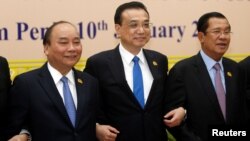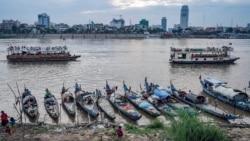Chinese Premier Li Keqiang on Monday pledged to share year-round hydrological data for the Mekong River, addressing recent concerns raised by countries in the Lower Mekong who are facing low water levels and drought conditions during the current wet season.
The Chinese premier made the commitment during a summit of Lancang-Mekong leaders on Monday, after the Mekong River Commission (MRC), which has China only as a dialogue partner, called for year-round data sharing in June to improve flood and drought monitoring along the critical water body.
Lancang-Mekong Cooperation includes China and five lower Mekong countries – Cambodia, Laos, Thailand, Myanmar, and Vietnam. China’s absence as a member of the MRC means that it does not have to submit hydropower dam proposals to the intergovernmental body.
Speaking at the virtual summit, Li Keqiang said China had provided wet season hydrological data for the Lancang River, the name for the river in China, to the Mekong countries, and had offered a timely update of upstream water levels.
“China also made extra efforts to increase outbound water flow in drought season to help downstream lower countries to mitigate drought,” he said.
“Starting from this year, China will share Mekong River hydrological data the whole year with the Mekong countries,” Li Keqiang added.
A press release from the Cambodian Foreign Ministry lauded Chinese commitment to share more hydrological data and assistance in maintaining water resources cooperation.
Prime Minister Hun Sen, in his speech at the summit, said Cambodia had benefited from the Lancang-Mekong Cooperation with 55 projects funded by China to help Cambodia. He also appreciated the data sharing commitment from China.
“The joint agreement in finding a solution related to the most sensitive topic of trans-bordering water management is another major success in our cooperation,” he said.
While low water levels have plagued the Mekong River and affected the 60 million people dependent on it as an inland fishery, it has also resulted in a drier Tonle Sap lake. The MRC said in early August that the Tonle Sap, which relies on reverse flows from the Mekong River during the wet season, has recorded the lowest flows since 1997. The lake is critical as a source of fish, both for sustenance and livelihood, for the millions of Cambodians dependent on the lake.
At the time, the MRC’s chief executive officer, An Pich Hatda, appealed to all six countries along the Mekong River to share flow data in a “transparent and speedy” manner.
Cambodian government officials have also hinted at upstream hydropower dams in China causing low water levels downstream, but have routinely cited climate change and the El Nino effect as the cause of these issues.
In a press conference on August 11, Te Navuth, secretary-general of the Cambodia National Mekong Committee, said that the main reason for water shortages in the Mekong River and Tonle Sap lake was the absence of no rain and drought caused by the El Nino effect.
He conceded that the dams along the Mekong River had a minor contribution to low water levels.
Brian Eyler, the Southeast Asia program director at the Stimson Center in Washington D.C., said China’s pledge for year-round data sharing provided “little detail” about the kind of data that will be shared. He said China should share information related to dams on the upstream.
“China should share a full spectrum of indicators including operating conditions of all its 11 upstream dams and data on sediment flow and fish passage. Without these indicators, the Lower Mekong countries cannot assess the health of the river nor make best use of its resources,” he told VOA Khmer in an email.
The Stimson Center, which tracks development along the river, published data in April alleging that Chinese dams were restricting water flow downstream despite the upstream region getting high rainfall and snowmelt. This was contributing to low water levels and severe drought in the Lower Mekong Basin, the group said in its April report.









